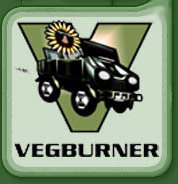Vegetable
Oil Engine Design and Engine Optimisation
1 The Diesel Engine
2 Theory of Vegetable Oil Use as a
Fuel
3 Engine suitability
4 Heating the Oil
5 Biodiesel
6 Micro Emulsions and Blends
7 Vegetable Oil Engine Design
8 Vegetable Oil Furnaces and Heaters
9 Oil Types and Filtering
10 Taxation
11 Implications of Vegetable Oil
Fuel Use
12 Sources
Although early compressed ignition engines were designed
to run on thick oils engine development since the early part
of the 20th century has concentrated mainly with the use of
diesel fuel in mind.
CI engines are however produced that are designed to run on
thick oils.
Stationary Engines
Large stationary engines are made that run on lower grades
of fuel oil, including thick crude oil full of impurities.
Thorough fuel heating and fuel filtration are utilised, injectors
are used that are designed to spray these thick oils efficiently.
The slow speed and size of these engines gives more time for
a complete burn of the fuel. A CI engine equipped to burn
such fuels is ready for SVO use.
Vegetable Oil Fuelled Vehicle Engines
Research and development has been carried out in engine
design that improves the operation with vegetable oil fuel.
Elsbett
The Elsbett family from Germany and their company have worked
extensively on CI engines throughout the last century, pioneering
many developments and receiving many accolades for their innovative
engineering work. They started production of a vegetable oil
fuelled engine in the late 1970’s and have been at the
forefront of developments ever since.
The Elsbett engine utilised the more efficient direct injection
engine with the combustion chamber within the piston. The
piston / combustion chamber was specially designed to give
an excellent seal and retain heat (energy) inside the combustion
chamber. The air and fuel flows within the engine were carefully
engineered so as to have the fuel injected into a mass of
hot air at the centre of the combustion chamber surrounded
by an insulating layer of cooler air. A self cleaning, single
holed injector is positioned to deliver fuel directly into
the hot air where it is completely combusted before it reaches
the combustion chamber walls avoiding deposit formation. With
larger engines two injectors are utilised to ensure that the
fuel can be injected quickly, as a long injection period causes
greater soot emissions.
Elsbett also convert existing diesel vehicles to run on vegetable
oil. The process involves installation of electric and coolant
fuel heaters and modification of the injectors. They do not
recommend the use of waste oil with these conversions although
people have used carefully cleaned waste oil for fuel.
Knickpleuel engine
Another German, Gerhard Mederer, changed the design of the
engine connecting rod. The connecting rod is articulated which
allows the piston to stay at top dead centre for longer keeping
the fuel burning within the combustion chamber in the piston
for longer. Also the power transmission to the crankshaft
is increased and lateral forces are decreased compared to
an engine equipped with a standard connecting rod . Due to
the combustion characteristics engines thus equipped have
been successfully fuelled with vegetable oil.
Engine Optimisation
Work has been done with altering existing diesel engines
to improve the combustion characteristics with vegetable oil.
Injectors
Injectors are designed to give optimum performance in a
given engine running on a given fuel. The design of the injector
will effect its suitability to run vegetable oil. The design
of the nozzles can aid combustion and effect both power and
fuel consumption [2]. Elsbett conversion
kits include replacement nozzles.
Increasing the injectors opening pressure has been found
to improve the spray pattern of the injector with higher viscosity
fuels (suggested pressure increase between 10-20 bar). An
Elsbett conversion involves increasing the opening pressure
by 5 bar
An Indian study found that lowering the injector pressure
on an engine with a fixed load running at 1500rpm gave better
fuel economy [21]
Studies have shown that moving the injector into a higher
position in the combustion chamber can reduce Nitrous Oxide
(NOX) emissions. Moving it above a certain amount increases
other emissions and greatly reduces performance. Altering
the timing of the injector pump to give a later fuel delivery
also decreases NOX emissions. These effects have been combined
to reduce NOX emissions by 75%. By doing this a power loss
of up to 17% can be expected at higher engine speeds. [2]
Combustion Chamber
Another study used a ceramic insulating layer attached to
the piston of a DI engine and found that combustion chamber
deposits were reduced to an acceptable level . It was found
that combustion chamber surfaces would vaporise vegetable
oil at temperatures above 500 deg C. The surface of the insulated
combustion chamber would reach this temperature. The engine
however used more fuel due to energy lost due to heat transfer
to the combustion chamber walls [9]
Injector Pump
Vegetable oil use has lead to injector pump malfunctions.
Rotary type injector pumps have been found to be particularly
vulnerable. These failures have been generally attributed
to the extra stresses pumping a more viscous fuel and impurities
in waste oil.
Adding an additional pump to aid the transfer of oil from
the fuel tank to the injector pump and altering the tolerances
within the injector pump to provide operating pressures similar
to that with diesel has given good results.
1 The Diesel Engine
2 Theory of Vegetable Oil Use as a
Fuel
3 Engine suitability
4 Heating the Oil
5 Biodiesel
6 Micro Emulsions and Blends
7 Vegetable Oil Engine Design
8 Vegetable Oil Furnaces and Heaters
9 Oil Types and Filtering
10 Taxation
11 Implications of Vegetable Oil
Fuel Use
12 Sources
|



